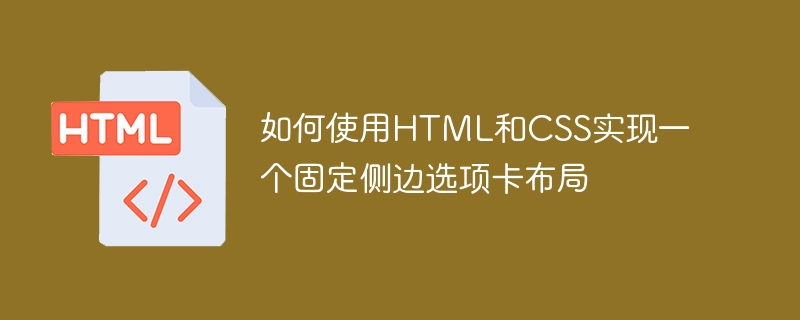

How to use HTML and CSS to implement a fixed side tab layout
In web design and development, it is often necessary to implement a fixed side tab layout. Use Used to display different content or navigate different pages. This article will introduce how to use HTML and CSS to achieve such a layout, and provide specific code examples.
1. HTML structure
First, we need to define the HTML structure to organize our tab layout. There will usually be a sidebar and a main content area. The sidebar is used to place tab buttons, and the main content area is used to display the content corresponding to the tab.
The following is a basic HTML structure example:
<!DOCTYPE html>
<html>
<head>
<link rel="stylesheet" type="text/css" href="style.css">
</head>
<body>
<div class="sidebar">
<button class="tab-button" onclick="openTab(event, 'tab1')">选项卡1</button>
<button class="tab-button" onclick="openTab(event, 'tab2')">选项卡2</button>
<button class="tab-button" onclick="openTab(event, 'tab3')">选项卡3</button>
</div>
<div class="content">
<div id="tab1" class="tab-content">
<h2>选项卡 1 内容</h2>
<p>这是选项卡1的内容。</p>
</div>
<div id="tab2" class="tab-content">
<h2>选项卡 2 内容</h2>
<p>这是选项卡2的内容。</p>
</div>
<div id="tab3" class="tab-content">
<h2>选项卡 3 内容</h2>
<p>这是选项卡3的内容。</p>
</div>
</div>
<script src="script.js"></script>
</body>
</html>In the above code, we use a div element as the sidebar and place several buttons as tabs. The main content area uses several div elements, and manages different tab content by setting a unique id for each div element.
2. CSS Style
Next, you need to use CSS style to define the style and behavior of the tab layout.
First, add styles to the sidebar and tab buttons:
.sidebar {
width: 200px;
background-color: #f1f1f1;
padding: 20px;
}
.tab-button {
display: block;
width: 100%;
padding: 10px;
margin-bottom: 10px;
border: none;
background-color: #ddd;
text-align: left;
cursor: pointer;
}
.tab-button:hover {
background-color: #bbb;
}
.tab-button.active {
background-color: #ccc;
}The above style code defines the width, background color, padding and other styles of the sidebar, as well as the tab button The width, padding, border and other styles. At the same time, the hover style and active style of the tab button are also defined.
Then, define the style for the tab content:
.content {
margin-left: 200px; /* 与侧边栏宽度一致 */
padding: 20px;
}
.tab-content {
display: none; /* 默认隐藏所有选项卡内容 */
}
.tab-content.active {
display: block; /* 显示选中的选项卡内容 */
}The above style code uses the margin-left attribute to align the main content area with the sidebar, and uses the display attribute to control the tab content. Show and hide. By default, all tab content is hidden and only the selected tab content is displayed.
3. JavaScript behavior
In order to make the tab layout work properly, we also need some JavaScript code to handle the click event of the tab button, and display the corresponding according to the clicked tab button Tab content.
The following is a basic JavaScript sample code:
function openTab(event, tabName) {
var i, tabContent, tabButton;
// 隐藏所有选项卡内容
tabContent = document.getElementsByClassName("tab-content");
for (i = 0; i < tabContent.length; i++) {
tabContent[i].style.display = "none";
}
// 移除所有选项卡按钮的 active 样式
tabButton = document.getElementsByClassName("tab-button");
for (i = 0; i < tabButton.length; i++) {
tabButton[i].className = tabButton[i].className.replace(" active", "");
}
// 显示选中的选项卡内容和添加 active 样式
document.getElementById(tabName).style.display = "block";
event.currentTarget.className += " active";
}The above JavaScript code uses the openTab function to handle the click event of the tab button. This function first hides all tab content, then removes the active style of all tab buttons, and finally displays the selected tab content and adds the active style.
Finally, you need to save the above CSS style code and JavaScript code as style.css and script.js files respectively, and introduce them into the HTML file.
4. Summary
Through the above HTML structure, CSS style and JavaScript code, we can implement a basic fixed side tab layout. When the user clicks on different tab buttons, the corresponding tab content will be displayed, and the tab button will have a corresponding style to indicate the selected state.
Of course, the above example is just a basic implementation, and you can further customize and optimize the layout and style according to actual needs. I hope this article was helpful in implementing a fixed side tab layout using HTML and CSS.
The above is the detailed content of How to implement a fixed side tab layout using HTML and CSS. For more information, please follow other related articles on the PHP Chinese website!